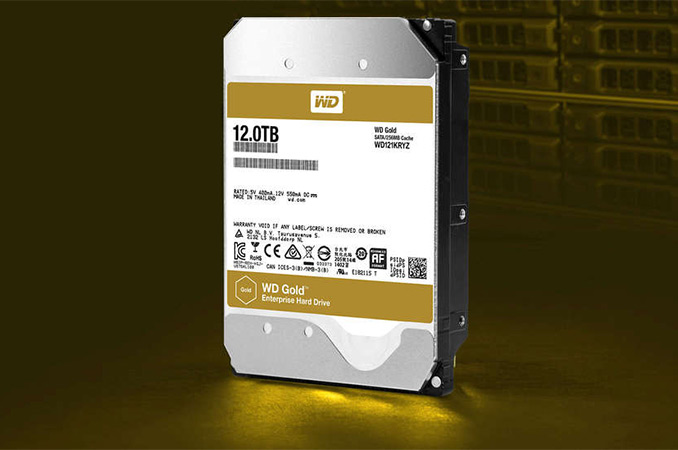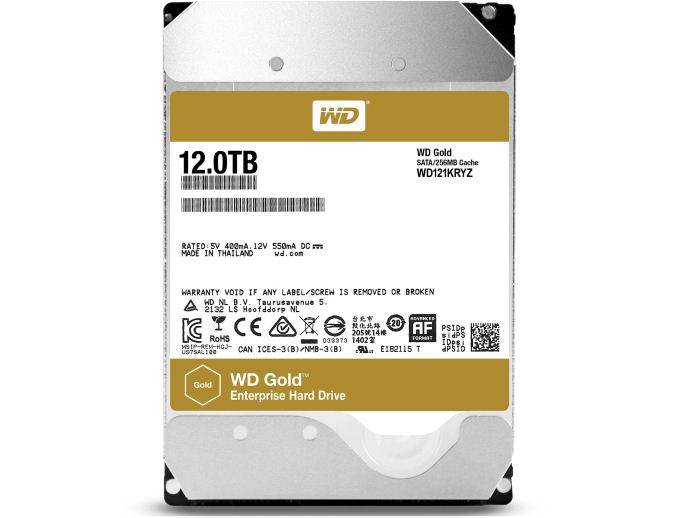Western Digital Ships 12 TB WD Gold HDD: 8 Platters and Helium
by Anton Shilov on September 16, 2017 9:00 AM EST- Posted in
- HDDs
- Storage
- WD
- Western Digital
- Helium HDD
- WD Gold

Western Digital has begun to ship its WD Gold HDD with 12 TB capacity to partners and large retailers. The 3.5” drive relies on the same platform as the HGST Ultrastar He12 launched this year, and will initially be available to select customers of the company. The WD Gold 12 TB is designed for enterprise workloads and has all the performance and reliability enhancements that we come to expect, but the availability at retail should make them accessible to wider audiences.
From a hardware point of view, the WD Gold 12 TB is similar to the HGST Ultrastar He12 12 TB hard drive: both are based on the fourth-generation HelioSeal technology that uses eight perpendicular magnetic recording platters with a 1.5 TB capacity for each platter. The internal architecture of both HDDs was redesigned compared to predecessors to accommodate the eighth platter. Since the WD Gold and the Ultrastar He12 are aimed at nearline enterprise environments, they are equipped with various sensors and technologies to protect themselves against vibration and as a result, guarantee sustained performance. For example, the WD Gold and the Ultrastar He12 attach their spindles both to the top and the bottom of the drives. In addition the HDDs feature a special technology that increases the accuracy of head positioning in high-vibration environments to improve performance, integrity, and reliability. Finally, both product families support TLER (time-limited error recovery) rebuild assist mode to speed up RAID recovery time.
Since the WD Gold 12 TB and the HGST Ultrastar He12 are similar internally and feature the same 7200 RPM spindle speed, they also have similar performance — the manufacturer puts them both at 255 MB/s sustained transfer rate and 4.16 ms average latency. The main difference between the WD Gold and the HGST Ultrastar He12 are the enterprise options for the latter: there are models with the SAS 12 Gb/s interface and there are models with SED support and Instant Secure Erase feature.
| Comparison of Western Digital's WD Gold HDDs | ||||||||
| WD121KRYZ | WD101KRYZ | WD8002FRYZ | WD6002FRYZ | WD4002FRYZ | ||||
| Capacity | 12 TB | 10 TB | 8 TB | 6 TB | 4 TB | |||
| RPM | 7200 RPM | |||||||
| Interface | SATA 6 Gbps | |||||||
| DRAM Cache | 256 MB | 128 MB | ||||||
| NAND Cache | Unknown | No | Yes | Unknown | ||||
| Helium-Filling | Yes | No | ||||||
| Data Transfer Rate (host to/from drive) | 255 MB/s | 249 MB/s | 205 MB/s | 226 MB/s | 201 MB/s | |||
| MTBF | 2.5 million | |||||||
| Rated Annual Workload | 550 TB | |||||||
| Acoustics (Seek) | - | 36 dBA | ||||||
| Power Consumption | Sequential read | 7 W | 7.1 W | 7.2 W | 9.3 W | 9 W | ||
| Sequential write | 6.8 W | 6.7 W | 7 W | 8.9 W | 8.7 W | |||
| Random read/write | 6.9 W | 6.8 W | 7.4 W | 9.1 W | 8.8 W | |||
| Idle | 5 W | 5.1 W | 7.1 W | 7 W | ||||
| Warranty | 5 Years | |||||||
| Price as of September 9, 2017 | MSRP | $521.99 | $410.99 | $327.99 | $244.99 | $183.99 | ||
| Per GB | $0.0435 | $0.0411 | $0.041 | $0.0408 | $0.046 | |||
| GB per $ | 22.98 GB | 24.33 GB | 24.39 GB | 24.48 GB | 21.73 GB | |||
Western Digital aims its WD Gold and HGST Ultrastar He-series drives at operators of cloud and exascale data centers that demand maximum capacity. The 12 TB HDDs can increase the total storage capacity for a single rack from 2440 TB to 2880 TB, replacing 10 TB drives with 12 TB drives, which can be a major benefit for companies that need to maximize their storage capacity per watt and per square meter. Where the HGST-branded drives are made available primarily through B2B channels, the WD Gold are sold both through B2B and B2C channels and thus can be purchased by wider audiences. For example, boutique PC makers, as well as DIY enthusiasts, may start using the WD Gold 12 TB for their high-end builds, something they could not do with the HGST drives. These HDDs may be considered as an overkill for desktops, but since WD’s desktop offerings top at 6 TB, the WD Gold (and the perhaps inevitable future WD Red Pro 12 TB) is the WD’s closest rival for Seagate’s BarraCuda Pro drives.
The WD Gold HDD is currently available directly from Western Digital for $521.99 as well as from multiple retailers, including Newegg for $539.99. While over $500 for a hard drive is expensive, it is actually less than Western Digital charged for its WD Gold 8 TB about 1.5 years ago ($595) and considerably less than the initial price of the WD Gold 10 TB drive last April.
Related Reading:
- Western Digital: Sales of Helium-Filled HDDs Accelerating, 15M Sold So Far
- Western Digital Starts Shipments of HGST Ultrastar He12 12 TB HDDs
- Western Digital Expands Purple Lineup with a 10 TB Helium-Filled HDD
- Western Digital Announces Ultrastar He12 12 TB and 14 TB HDDs
- Western Digital Adds Helium-Filled WD Gold 10 TB HDD to Lineup
Source: Western Digital











62 Comments
View All Comments
chaos215bar2 - Sunday, September 17, 2017 - link
Very strange, and WD doesn't seem to be keen on describing what's different. WD Red Pro is clearly marketed as a "NAS" drive, while the Gold is marketed for "Enterprise". Gold does seem to have better specs, but maybe Red has better shock protection? Everything I can find is basically marketing gobbledygook.DanNeely - Sunday, September 17, 2017 - link
They should be fine. Enterprise drives need to be vibration tolerant enough to survive being stuffed into a rack full of HDDs. WD's Red and Red Pro drives launched being rated as vibration tolerant in 4 and 8 drive arrays respectively (although I think WD raised the limit a few years later).10 TB Red Pro prices do look off at the moment though vs the Gold drives. I'd expect the prices to normalize over time though; I'm guessing it's just retailers dragging their feet on price drops to try and maximize what they can get out of their existing stock; especially if they're a low volume dealer and are stuck with having bought a lot of the Red Pros at a higher wholesale price.
Samus - Sunday, September 17, 2017 - link
This drive is orgasmic. I'm glad WD bought Hitachi.Visual - Sunday, September 17, 2017 - link
Considering I paid 200 EUR (so like $240) for a 8TB LaCie Porsche Design USB 3, their pricing for 12TB is nuts. HDD manufacturers are really getting greedy these last few years...damianrobertjones - Sunday, September 17, 2017 - link
If people will pay they'll keep raising that price.thewishy - Monday, September 18, 2017 - link
Pricing for the highest capacity points has always been non-linear. Some will pay because the associated costs (Drive trays, rack space, higher end NAS, electric etc) make it worthwhile for them. Others will go for the price/capacity sweet spot, 8tb at the moment I believe - which is where the manufacturers have the most available production and don't need to faf around with helium to match the required density.Vatharian - Sunday, September 17, 2017 - link
It is nice to see they started to offer 10 TB drives, at last! 10.9TB, even! Pointing they money grab aside, it will take at least 12h 27min to fill the highest capacity drive. Insane!Lolimaster - Monday, September 18, 2017 - link
HARM still nowhere to be found, I would never consider an HDD with more than 4 platters.Wolfpup - Monday, September 18, 2017 - link
And these are REGULAR drives, not that "shingled" stuff?Man, 12TB...I bought 2 8TB drives a year or two ago when they were the largest. Glad we finally seem to be growing in size, though they're EXPENSIVE. Drive sizes are just not keeping up with the need to store data.
And I guess "Gold" is the Enterprise/server drive from WD, while "Red/Red Pro" is the NAS/almost-enterprise drive? (My 8TB drives are Seagate, sans catchy name lol)
Cyanara - Monday, September 18, 2017 - link
Oh, I'm sure they're shingled. That was how they made 10TB possible. There doesn't seem to be a big hit to write performance as predicted though.